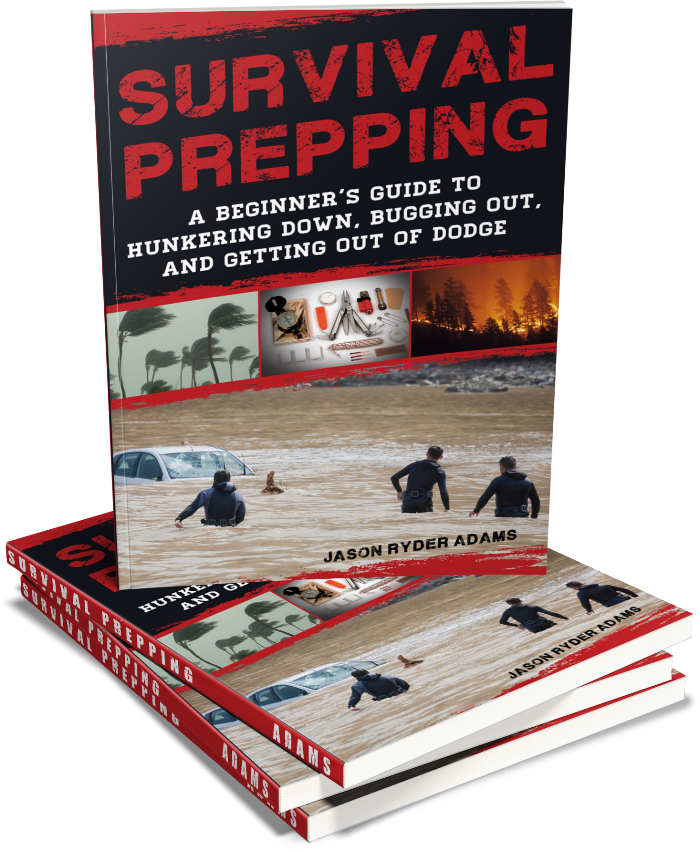From the Book Survival Prepping by Jason Ryder Adams

Your Hunker Down Supplies Checklist
Print this checklist on your printer, and use it to build up your emergency supplies.
Water
Store away from dangerous chemicals. Change out with fresh water every 6 to 12 months
▢ 3 gallons per person per day - store in containers and date each container
▢ Containers for water storage (55 gallon drums or other approved containers)
▢ Pans for boiling
▢ Camping water filter
▢ Distilling flask
▢ Chlorine bleach (unscented, 8.25 percent hypochlorite, label says suitable for disinfections and sanitation)
Food
Inspect every 6 to 12 months for expiration date
▢ Enough food for three meals per day per person, plus snacks
▢ Canned meats, soups, chili, beans, and stews
▢ Canned fruits and vegetables
▢ Aseptic packaged soup, fruit juices, and drinks
▢ MRE packaged meals, self-heating
▢ Dehydrated camping meals
▢ Peanut butter or other nut butters
▢ Snack bars made of granola, protein or fruit
▢ Dry cereals or granola
▢ Dried fruit
▢ Shelled nuts
▢ Crackers that can substitute for bread
▢ Canned, pasteurized milk
▢ Vitamins and other dietary supplements
▢ Infant foods and formulas
▢ Comfort foods
▢ Charcoal stove (for outdoor use) or indoor propane stove
▢ Charcoal
▢ Lighter fluid
▢ Propane for indoor propane stove
▢ Spatulas for grill
▢ Grill cleaner
▢ Hot plate (if electricity is available)
▢ Paper towels
▢ Sharp knife
▢ Eating utensils - plastic knives, forks, spoons, plates, and cups
▢ Trash bags
▢ Can opener
▢ Dish soap
Hygiene
▢ Garbage bags for everyday waste
▢ Garbage bags for human waste (placed over toilet bowl)
▢ "Honey Buckets" (special containers for storing waste)
▢ Quicklime to neutralize human waste
▢ Baking soda to neutralize human waste
▢ Specialized waste buckets
▢ Hand soap
▢ Alcohol based sanitary wipes
▢ Toothbrushes and toothpaste
▢ Toilet paper
▢ Facial tissues
First Aid Kit
▢ First aid booklet
▢ Sterile gauze, both 2x2 and 4x4 sizes
▢ Medical tape - either paper, silk or plastic
▢ Adhesive bandages in multiple sizes
▢ Several rolls of three or four inch self-adherent elastic wrap
▢ Compression wraps - at least two four inch wraps
▢ Several antiseptic wipes
▢ Antibacterial liquid soap
▢ Triple antibiotic ointment - preferably with lidocaine
▢ One bottle of hydrogen peroxide
▢ A tube of anti-itch cream
▢ One bottle of chewable aspirin tablets, commonly referred to as baby aspirin
▢ Tweezers
▢ Bandage scissors
▢ A few large safety pins
▢ Medical grade cold compresses
▢ Calamine lotion
▢ Cotton balls
▢ One bottle of alcohol or a box of alcohol wipes
▢ Thermometer
▢ Latex gloves - use polyurethane or vinyl if you have a latex allergy
▢ Small flashlight with batteries
▢ Small box of diphenhydramine/antihistamine allergy tablets
▢ Tongue depressors
▢ Several bottles of water
▢ Epipens for those with life-threatening allergies
▢ Over-the-counter NSAID medications (ibuprofen) and other pain relievers
▢ Up-to-date prescription medication for those with medical needs
Communications
▢ Corded, non-electric phone attached to landline
▢ Cell phone and/or satellite phone
▢ External batteries or extra charged batteries for cell/satellite phone (or solar cell phone charger)
▢ Battery powered transistor radio or an NOAA Weather Alert Radio
▢ Extra batteries for radio (or solar powered radio or hand-cranked radio)
▢ Ham radio, CB Radio, or walkie-talkies
▢ Back up batteries or backup generator for radios
▢ Printed or written list of all emergency contact phone numbers.
Children
▢ Diapers
▢ Toys, books, and entertaining diversions
▢ Favorite pillows, blankets, clothing
Pets
▢ Food and water
▢ Medicine
▢ Collar with ID
▢ Pet carrier
▢ First aid kit: cotton bandage rolls, tape, scissors, flea and tick prevention, gloves, a pet first aid book, antibiotic ointment and an isopropyl alcohol and saline solution
▢ Sanitation: litter, newspapers, trash bags and bleach
▢ Toys
▢ Treats
General Equipment
▢ Flashlights - a battery-powered lantern is helpful for long power outages - extra batteries
▢ Whistle or personal siren - A loud noise can save lives in a debris field
▢ Infant supplies - Diapers, baby wipes, fresh formula, medicine
▢ Air filtering materials -masks or cotton t-shirt to use as a breathing filter
▢ Shelter-in-place - Plastic sheeting, scissors, and duct tape to cover doors and windows
▢ Tools to turn off utilities - Wrench or pliers
Clothing and Bedding
Climate is a major consideration in the selection of clothing for the emergency kit. Power outages can remove the ability to heat and cool the interior of the home. Clothing and bedding must be replenished to adjust for growing children and new family members.
Clothes for EACH person must be included in the kit.
▢ A coat or jacket
▢ Long pants or jeans
▢ A long-sleeved shirt
▢ Sturdy walking shoes
▢ Hat and gloves
▢ Sleeping bag or warm blanket
Specialty Supplies
Certain situations will dictate the need for special equipment that will be helpful. As you build an emergency kit for your family, consider which of the items on this list would be helpful.
▢ Rain gear in wet climates
▢ Cash and change for immediate needs, including gasoline
▢ Paper towels
▢ Pencil and paper
▢ Tent
▢ Fire extinguisher
▢ Matches in a sealed container
▢ Compass
▢ Signal flare
▢ Feminine hygiene supplies
▢ Disinfectant
▢ Personal hygiene items
▢ Spare eyeglasses and/or contacts
▢ Medicine dropper
▢ Chlorine bleach - already mentioned under "Water" but a germ-killing cleaner for many uses.
▢ Books and other diversions for the adults
▢ Permanent marker (for labeling cans)
Home Equipment
▢ Generator (standby or portable)
▢ Gas for generators
▢ Extension cords for generators
▢ Heater - Electric, kerosene, or propane
▢ Extra fuel for heaters
▢ Chainsaw
▢ Shovels and tools
▢ Work gloves
